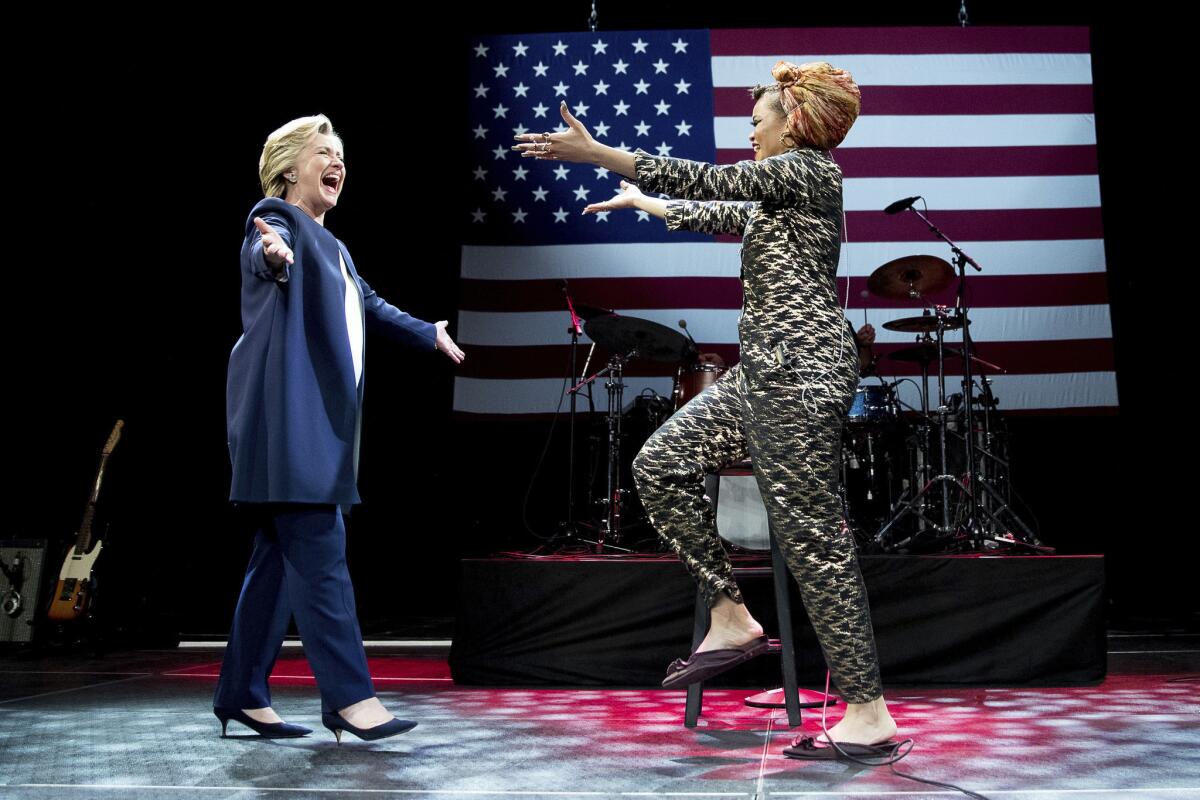Hillary Clinton keeps fishing for big money while lagging behind with smaller donors
Reporting from San Francisco — Shortly after Michelle Obama finished a rousing speech denouncing Donald Trump’s behavior toward women, Hillary Clinton’s campaign texted supporters asking them to “chip in $1 to fight for women.”
But that wasn’t where the big dollars were coming from. Later that night, Clinton flew to Beverly Hills for a dinner with donors and a performance from Elton John — the minimum ticket was $33,400, and $100,000 earned supporters premium seating.
Although it’s not unusual for a presidential nominee to hold fundraisers close to the finish line — President Obama attended at least eight in October 2012 — Clinton’s schedule, which included three such events on the West Coast this week, reflects her deep reliance on wealthy contributors. Trump, who far outpaces her in the share of small donations that make up his fundraising total, has accused her of being beholden to special interests buying influence through large donations to her campaign.
“Why don’t you put $10 million or $20 million or $25 million or $30 million into your own campaign? It’s $30 million less for special interests that will tell you exactly what to do,” he said at their second debate Sunday in St. Louis.

Just 24% of donations to Clinton’s campaign committee came in chunks of less than $200 as of Aug. 31, according to the most recent Federal Election Commission figures available. Obama, with his vast fundraising network, pulled in 48% at the same point in 2012 and 36% in 2008.
Trump outdid them both, getting 65% of his money from donations under $200, a lopsided figure that reveals not only excitement from his supporters but his struggle to tap the rich contributors that Republican candidates have counted on in the past.
Clinton’s campaign, citing internal calculations, insists that it has widespread support among small-dollar donors. Low-dollar contributions will become more critical for Clinton as election day draws closer, campaign manager Robby Mook predicted.
“As the amount of time the secretary and her surrogates spend fundraising [decreases], it’s our online donors who almost exclusively will be supporting the campaign,” he said on a conference call with reporters.
A campaign official also said that the true breadth of Clinton’s grass-roots fundraising is not easily quantifiable by a traditional measure — the number of contributions less than $200 reported to the Federal Election Commission — given low-dollar donors’ penchant for giving repeatedly.
Using a different formulation that includes low-dollar contributors who made additional donations until their total exceeded $200, grass-roots fundraising made up half of the campaign’s total, the official said. More than 142,000 donors who originally donated less than $200 gave again, pushing their total past that line.
The campaign also pointed to the Hillary Victory Fund, a joint fundraising committee with the Democratic Party that is a vehicle for bite-sized donations. When both accounts are included, more than $231 million has been raised in chunks of $200 or less through the end of September, according to the campaign official, who requested anonymity to provide greater detail about fundraising.
Follow today’s coverage of the presidential campaign on Trail Guide »
But Clinton aides also acknowledge inherent barriers to generating the kind of windfall that powered Obama’s campaigns and ultimately became a central part of Vermont Sen. Bernie Sanders’ underdog effort against Clinton in the Democratic primary.
For starters, she was a significant favorite in the race, making it difficult to convince her supporters that contributions of $5, $10 or even $100 would be needed. Her database of active email addresses for her supporters, a key revenue-raising engine in modern politics, had been dormant for years and needed to be rebuilt as the campaign went on.
It became a hurdle for Clinton in the primary as her smaller pool of donors bumped up against contribution limits set by federal law as Sanders continued to rake in tinier donations online.
Even after securing the nomination, she has struggled to match the breadth of Sanders’ fundraising network. Sanders had received money from 2.8 million individual donors by the end of June, while Clinton reached 2.6 million at the end of September between her campaign committee and a joint fundraising account with the Democratic Party, according to the campaigns.
Clinton’s difficulties tapping small donors support may reflect a lack of passion for her among the Democratic grass roots, who don’t see her as the leader of a movement they want be a part of, the way many perceived Obama or Sanders.
Small-dollar donations can be a sign not only of financial health but enthusiasm for a candidate, said Brendan Glavin, the data manager at the Campaign Finance Institute, a nonpartisan Washington think tank.
“If people are giving $5 or $10 to a candidate, they’re going to have an engagement with the campaign,” he said.
Another challenge for Clinton is that Trump doesn’t seem to motivate her supporters to chip in, said Michael Whitney, who was the digital fundraising manager for Sanders’ primary run.
“A lot of people don’t believe he can win,” he said of Trump. “As much as you say he’s a threat to people, there’s a lack of believability there.”
Clinton has been doing relatively well given that small-dollar donors were unlikely to to flock to her in the first place, said Nicco Mele, director of Harvard’s Shorenstein Center on Media, Politics and Public Policy.
“Establishment candidates tend to struggle to raise money online,” said Mele, the former deputy publisher of The Times. “Online fundraising tends to favor more extreme positions and underdog candidates.”
Email lists are the biggest conduit for raising money online, and fundraisers said it’s important to capitalize on exciting moments during campaigns to make supporters reach for their credit cards.
Mook said Clinton’s campaign has seen significant spikes in its online and low-dollar fundraising around such big events as the Democratic National Convention and the first two debates. An email sent to supporters on the night of the first debate generated the campaign’s biggest small-dollar windfall of the year.
“We certainly expect to see that before and during the next debate,” Mook said.
Clinton clearly has the edge when it comes to money, said Lindsay Mark Lewis, a former national finance director for the Democratic Party. She finished August with $68.4 million in the bank, while Trump had $50.2 million, according to federal filings.
“She’s in great shape financially,” he said.
Lewis added, “She doesn’t have the same appeal as Obama or Sanders to the grass-roots donor network. Yet they’ve built a pretty strong list. Now the campaign has an opportunity to unleash that.”
If Clinton keeps her solid lead in the polls, some of that money could be spread throughout the Democratic Party to help candidates trying to pry back control of Congress from Republicans.
“They’re the ones who need the money in the last two weeks,” Lewis said.
Memoli reported from San Francisco and Megerian from Sacramento.
Twitter: @chrismegerian, @mikememoli
ALSO
Hillary Clinton is exploring the outer limits of fundraising like no presidential nominee ever has
Why Trump and Clinton sleep in their own beds most nights even though they’re on the campaign trail
Michelle Obama delivers what may be a defining moment in the presidential campaign
More to Read
Get the L.A. Times Politics newsletter
Deeply reported insights into legislation, politics and policy from Sacramento, Washington and beyond. In your inbox three times per week.
You may occasionally receive promotional content from the Los Angeles Times.












